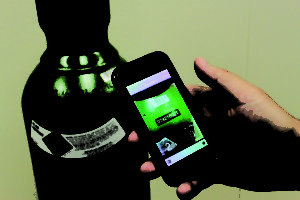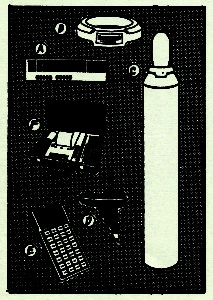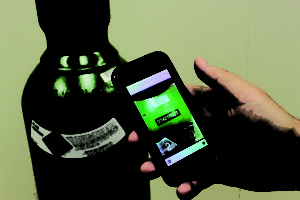I was very honored to be asked to write an article on the history of gas cylinder tracking systems for the 25th Anniversary Issue of CryoGas International Magazine. I'm proud that TrackAbout has been a leader in developing asset tracking technology for the industrial gas industry for the past 15 years. That experience has given me a chance to watch this technology grow from its infancy.
I am especially excited that TrackAbout, together with our affiliate company Lockhouse, is helping to build the future industrial supply chain. So the article is also about the future of cylinder tracking, and how technology in use now both creates and solves the increasing demands for better information in real time, all along the supply chain.
This article originally appeared in the September 2015 issue of gasworld. It is reprinted with permission.
- Licensed under CC BY-SA 3.0 via
Wikimedia Commons.
Most people are familiar with the bulkiness of the first computers and the first cellphones. Similarly, in the 1980s, rugged handheld scanners used in industrial applications were the size of large bricks, and just as heavy. They usually stopped working when dropped, which happened often, especially when users got frustrated with them. If you wanted to print a receipt for what had been scanned, you had to attach the handheld via cable to a printer, a printer which was carried around in a case that resembled a briefcase. To be completely fair to 1980s-style scanners, the equipment ergonomics were only as good as the components that were available to build the devices at the time. Those components were large and hence the devices were big and cumbersome as well.
Despite these obstacles, at the time rugged handhelds were at the cutting edge in the budding field of devices that could read barcode labels. Barcodes were an emerging way to rapidly identify separate products or assets as unique and distinct units tied to data in a database, and they were beginning to be deployed across multiple industries. If a barcode label fell off a product, it could be replaced cheaply, unlike bulkier attachments. A barcode scan could auto-identify physical assets and eliminate error-ridden manual data entry. In 1974, the first grocery store barcode was scanned to help speed up the process of accurately tallying grocery bills at the register.
Collecting data and interpreting it via computer was in its infancy, but this kind of labeling and scanning system was starting to be deployed across multiple industries in the late 1970s and early 1980s. Early innovators like FedEx were using this budding label and scan system, deploying handheld scanners to track the packages they were shipping, despite the handheld’s drawbacks. Why? Because as more and more products and packages leave their owner’s sphere of control, manual methods of keeping track of them become increasingly inefficient and unmanageable; as FedEx CIO Rob Carter put it, “You can’t manage what you can’t measure.”
Managing What You Own
When Jack T. Butler, II was in his 20s and working the night shift at the family business, Butler Gas Products Company, he was asked by a friendly competitor who visited the Butler plant, “Where are all your empties?” Jack didn’t know exactly so he asked his father, Jack A. Butler, the founder of the business who said, “They are on our trucks being returned from customers.” Butler Gas was spending precious cash resources to buy their own cylinders rather than rent them from gas suppliers. Cylinders were expensive so they bought just enough to turn around from one customer and deliver the next day to another. There were no empties just sitting around.
According to Butler, the philosophy of owning your own cylinders, your own assets vs. renting them, is the same philosophy as owning your own house vs. renting it. This idea was compelling to Butler Gas then and continues to influence the gas industry as a whole. In 1945, an association of gas distributors had formed, calling itself NWSA (National Welding Supply Association), now known as GAWDA (Gases and Welding Distributors Association). At their meetings in the 1960s, the members discussed the favorable economics of owning their own cylinders, as well as their own filling equipment and production facilities.
At NWSA, Jack’s interest in emerging technologies landed him the job of Chairman of the Management Information Committee. The mission of that committee was to keep moving the independent gas distributor along with increased use of new technologies like cylinder tracking, palletized production plants, specialty gas filling, barcoding hardgoods, etc. Jack’s motto was, “Why technology? Because it works.”
An offshoot effort of the committee was called the Barcode Task Force. The task force’s first job was trying to decide what symbology to use for barcode labeling cylinders and hardgoods. It was a tossup and mixed reviews between two widely used barcode symbologies: one that could handle alphanumeric characters (3 of 9) and one that was all numeric (UPC). Connie Robinson (industry consultant), Bill Higley, and David Haas (both gas distributors) served on this task force along with Jack. Connie and Jack decided to visit Payne Brothers in Hammond, Indiana (an early adopter of tracking cylinders) in order to evaluate the barcode symbology being deployed.
What they discovered at Payne was the creative solution of walkie-talkies used to transmit cylinder serial numbers via the operator’s voice on the plant floor and transcribed in real time by the office staff. Barcode labels that were used on each cylinder matched the serial numbers indelibly stamped on the cylinder shoulder. That meant the barcode symbology had to be able to use both alpha and numeric characters; UPC therefore was ruled out and 3 of 9 won the day.
In 1986, Butler Gas — with a significant investment in their own cylinder assets — decided to do cylinder tracking using the Area Technologies’ system, which was upgraded to using the “brick-like” laser scanners to read barcodes. Jack remembers a big learning curve for his employees to adopt this new way of doing business. It took a very dedicated management team in order to keep everyone’s eye on the ball. Printing barcode labels (using the cylinder serial number) and labeling/initializing cylinders was a major project. Considering the time it took cylinders to return from the field, it took a couple years to fully label and initialize all of Butler Gas cylinders at that time.
Other than Area Technologies, there were a few other upstart cylinder tracking solutions initiated by industry-specific software companies like Barry Weir, Computers Unlimited, DataWeld, Infonetics, Trendex, Equinox, and TrackAbout, who had handfuls of customers that were doing cylinder tracking. Also there were some home-grown cylinder tracking projects initiated by General Air in Denver, Colorado, and Haun Welding in Syracuse, New York. Both continue to use their own tracking systems to this day.
In 1989, John Whiting, an industry veteran and consultant, was asked to do a Profit Improvement Study at Butler Gas. When John arrived for the study Jack Butler gave him a plant tour. John had experience with cylinder tracking when he worked at AGA and wanted to see what kind of accuracy Butler Gas was getting by conducting a random test. He wrote down a cylinder serial number he saw in the production facility and immediately climbed the stairs to the office and asked Sandy Gobrish, cylinder tracking administrator, “Where is the cylinder with this serial number?”
Sandy queried her tracking system database and said affirmatively, “That cylinder is downstairs in our production facility.”
“Impressive results,” John replied.
Onward and Outward
Along with the independent gas companies, by the 1990s and early 2000s, all the major gas suppliers were making forays into cylinder tracking. However, having large facilities spread out far from each other globally had its own unique set of challenges — ones that enterprise solutions at the time had a hard time handling. To deal with this technical gap, several of the majors set about building their own tracking systems in targeted regions around the world. Unfortunately, the early versions of these solutions often fell short as well — and many of them were abandoned by satellite plants months and years into using them.
In 2003, at Air Liquide, an engineer named Albert Atkins was given the task of trying to turn this trend around and manage a team that would find or build a tracking system that would deliver on its promises. Albert recalls, “In previous tries, tracking solutions were focused on meeting internal expectations regarding data management and reporting to better manage the business but forgot one key element — the operator experience for the filling plant and delivery drivers. What finally made the difference at Air Liquide was finding a solution that married the modern technology available to make the user experience as easy as possible with a customizable data-management and reporting tool that allowed the company to use the data collected to manage our assets in a better way, both internally and externally. Once we demonstrated the ability to do both, in a relatively cost-effective way, upper management was ready to support the project.”
Photo courtesy of TrackAbout, Inc.
According to Elizabeth Wallace (who led the tracking team at Air Liquide after Albert and is now VP of Product Management at TrackAbout), along with the confluence of the right technology coming about at the right time, what really made the difference this time for the majors was a renewed buy-in from upper management to create strong implementation teams, along with creating incentives for far-flung plants to fully adopt and use the technology. Once the right technology was adopted and embraced, these companies saw a return on investment and subsequently started building large parts of their business around these tracking solutions.
Elizabeth now says that she should “have a barcode tattooed” on her, after extensively traveling for the past eight years implementing tracking solutions at several of the major gas companies in a dozen countries. She believes that tracking technology is a “must have” industry solution that comes down to a simple philosophy, “To compete, you have to be able to know where your assets are.”
Today and Tomorrow
Independent and major gas companies have continued to upgrade their tracking systems over the years. Although the design of handheld scanners has rapidly improved since its early days, its costs have remained fairly high, and upfront investment is probably the major factor that has held back some in the industrial gas industry from adopting automated tracking systems. Although today’s leading tracking solutions end up paying for themselves multiple times over in ROI, that initial outlay of capital can be painful.
Luckily, because other products have rapidly evolved in the broader consumer market, in 2015 we now have devices that can rapidly scan barcodes, have all the same capabilities as rugged handhelds and then some, and are inexpensive to purchase or already exist in many people’s pockets. Those devices you already know, and probably already own: smartphones like iPhone and Android.
You may have already experienced being checked out of a store by an employee using a smartphone or tablet like a portable cash register and scanning device. New technology just released this year enables smartphone cameras to scan barcodes in succession and as rapidly and accurately as a rugged handheld. This is nothing short of revolutionary for any industry that uses barcodes to manage or track their products.
The near future (next 10 years) of cylinder tracking is bright. Billions of people already own and use smart mobile devices (tablets, smartphones, etc.). Barcodes are ubiquitous, and NFC (Near Field Communication) and more broadly RFID (Radio Frequency Identification) tags have become a reality. Rapid scanning of barcodes, QR codes, and reading of NFC tags by the affordable smart devices will increase adoption of cylinder tracking throughout the world. Of the several hundred million cylinders in the world today it is estimated that only about 10 percent are currently being tracked. It’s predicted by industry experts that smart device scanning will increase the number of assets tracked by 15 percent per year.
However, it’s not just tracking and quality control that the gas industry needs to be worried about as far as managing their assets. As the internet has put more and more information at consumers’ fingertips, consumers now demand (and expect) immediate information about the products they use; and so companies across many industries are faced with liability and customer service issues if they fail to provide that information in a timely manner. Yet another advantage of smartphones is that they can deliver that information to the asset user anywhere — including standing right in front of a product at its use point. Smartphones combined with asset management software solutions offer a really unique way of not only managing your assets, but also engaging those that use your assets.
Although not often discussed, one of the main reasons for FedEx’s incredible success was not simply its innovative tracking system that it developed for quality control, it was the fact that they offered information gleaned from this system to customers. In 1979, FedEx gave customers the ability to call in and find out where their package was, and in 1994 was one of the very first companies to allow customers to track packages online. Fedex.com was actually one of the very first examples of usable, searchable consumer information on the web, even predating all but the earliest web search engines.
FedEx, as well as the early tracking adopters in the gas industry, understood how important information was (and is) to success and profitability. To paraphrase Fred Smith, the founder of FedEx: The information about the asset is as important as the asset itself.
.png)






